Survey of World History: Crusades, Dynasties, Silk Road and Diseases
VerifiedAdded on 2022/11/28
|6
|1824
|266
Report
AI Summary
This report delves into three key areas of world history: the Crusades, the Umayyad and Abbasid dynasties, and the Silk Road. Part A explores the origins of the Crusades, examining the social, political, religious, and economic factors that fueled the crusading spirit in Europe. Part B analyzes the methods of expansion employed by the Umayyad and Abbasid dynasties, comparing their religious policies and political administrations, including the impact of hereditary succession and taxation. Part C investigates the Silk Road, its role as a trade route, and its connection to the spread of epidemic diseases, highlighting the transmission of parasitic worms and diseases like the bubonic plague. The report is based on scholarly sources and provides a comprehensive overview of these historical topics.
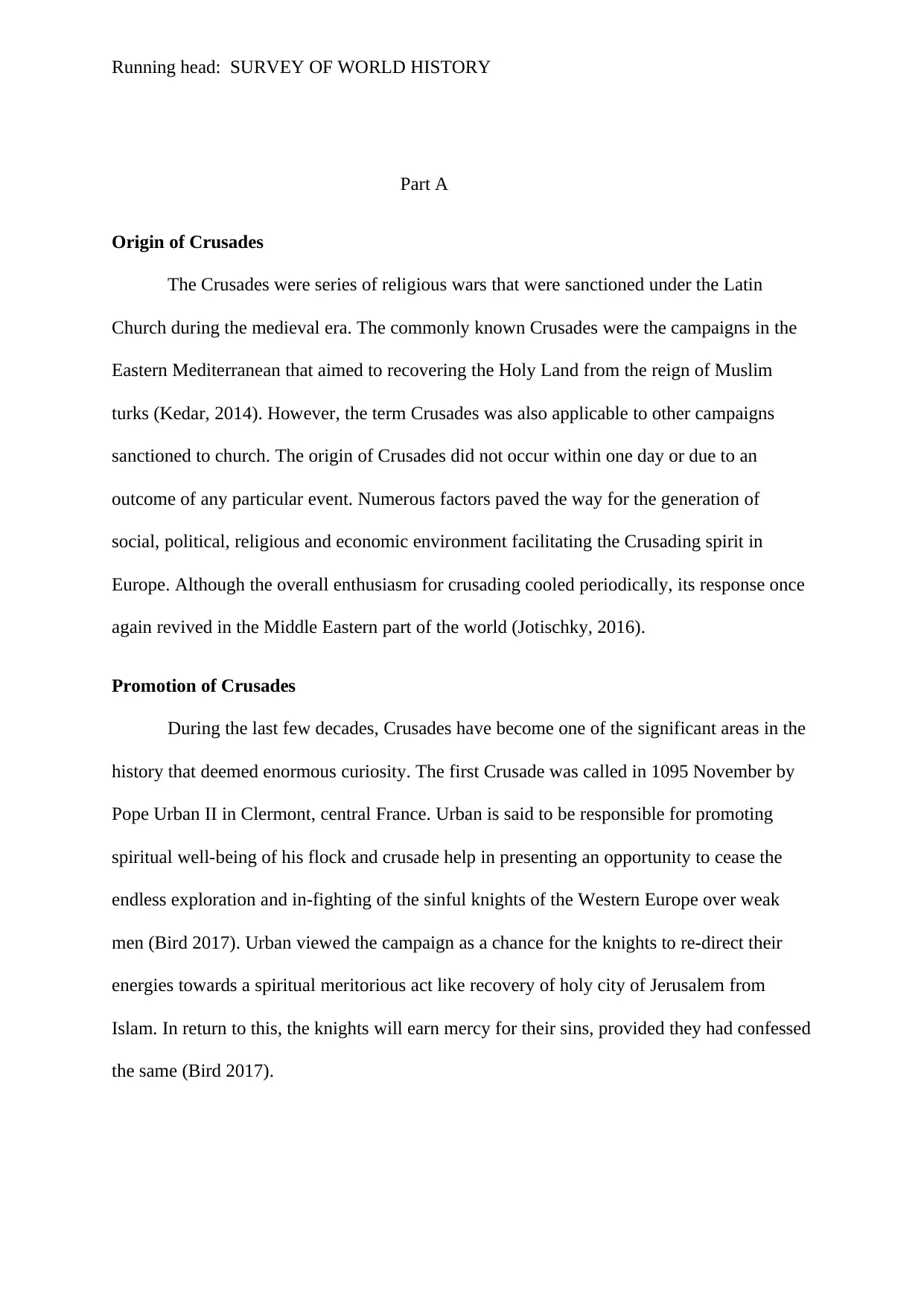
Running head: SURVEY OF WORLD HISTORY
Part A
Origin of Crusades
The Crusades were series of religious wars that were sanctioned under the Latin
Church during the medieval era. The commonly known Crusades were the campaigns in the
Eastern Mediterranean that aimed to recovering the Holy Land from the reign of Muslim
turks (Kedar, 2014). However, the term Crusades was also applicable to other campaigns
sanctioned to church. The origin of Crusades did not occur within one day or due to an
outcome of any particular event. Numerous factors paved the way for the generation of
social, political, religious and economic environment facilitating the Crusading spirit in
Europe. Although the overall enthusiasm for crusading cooled periodically, its response once
again revived in the Middle Eastern part of the world (Jotischky, 2016).
Promotion of Crusades
During the last few decades, Crusades have become one of the significant areas in the
history that deemed enormous curiosity. The first Crusade was called in 1095 November by
Pope Urban II in Clermont, central France. Urban is said to be responsible for promoting
spiritual well-being of his flock and crusade help in presenting an opportunity to cease the
endless exploration and in-fighting of the sinful knights of the Western Europe over weak
men (Bird 2017). Urban viewed the campaign as a chance for the knights to re-direct their
energies towards a spiritual meritorious act like recovery of holy city of Jerusalem from
Islam. In return to this, the knights will earn mercy for their sins, provided they had confessed
the same (Bird 2017).
Part A
Origin of Crusades
The Crusades were series of religious wars that were sanctioned under the Latin
Church during the medieval era. The commonly known Crusades were the campaigns in the
Eastern Mediterranean that aimed to recovering the Holy Land from the reign of Muslim
turks (Kedar, 2014). However, the term Crusades was also applicable to other campaigns
sanctioned to church. The origin of Crusades did not occur within one day or due to an
outcome of any particular event. Numerous factors paved the way for the generation of
social, political, religious and economic environment facilitating the Crusading spirit in
Europe. Although the overall enthusiasm for crusading cooled periodically, its response once
again revived in the Middle Eastern part of the world (Jotischky, 2016).
Promotion of Crusades
During the last few decades, Crusades have become one of the significant areas in the
history that deemed enormous curiosity. The first Crusade was called in 1095 November by
Pope Urban II in Clermont, central France. Urban is said to be responsible for promoting
spiritual well-being of his flock and crusade help in presenting an opportunity to cease the
endless exploration and in-fighting of the sinful knights of the Western Europe over weak
men (Bird 2017). Urban viewed the campaign as a chance for the knights to re-direct their
energies towards a spiritual meritorious act like recovery of holy city of Jerusalem from
Islam. In return to this, the knights will earn mercy for their sins, provided they had confessed
the same (Bird 2017).
Paraphrase This Document
Need a fresh take? Get an instant paraphrase of this document with our AI Paraphraser
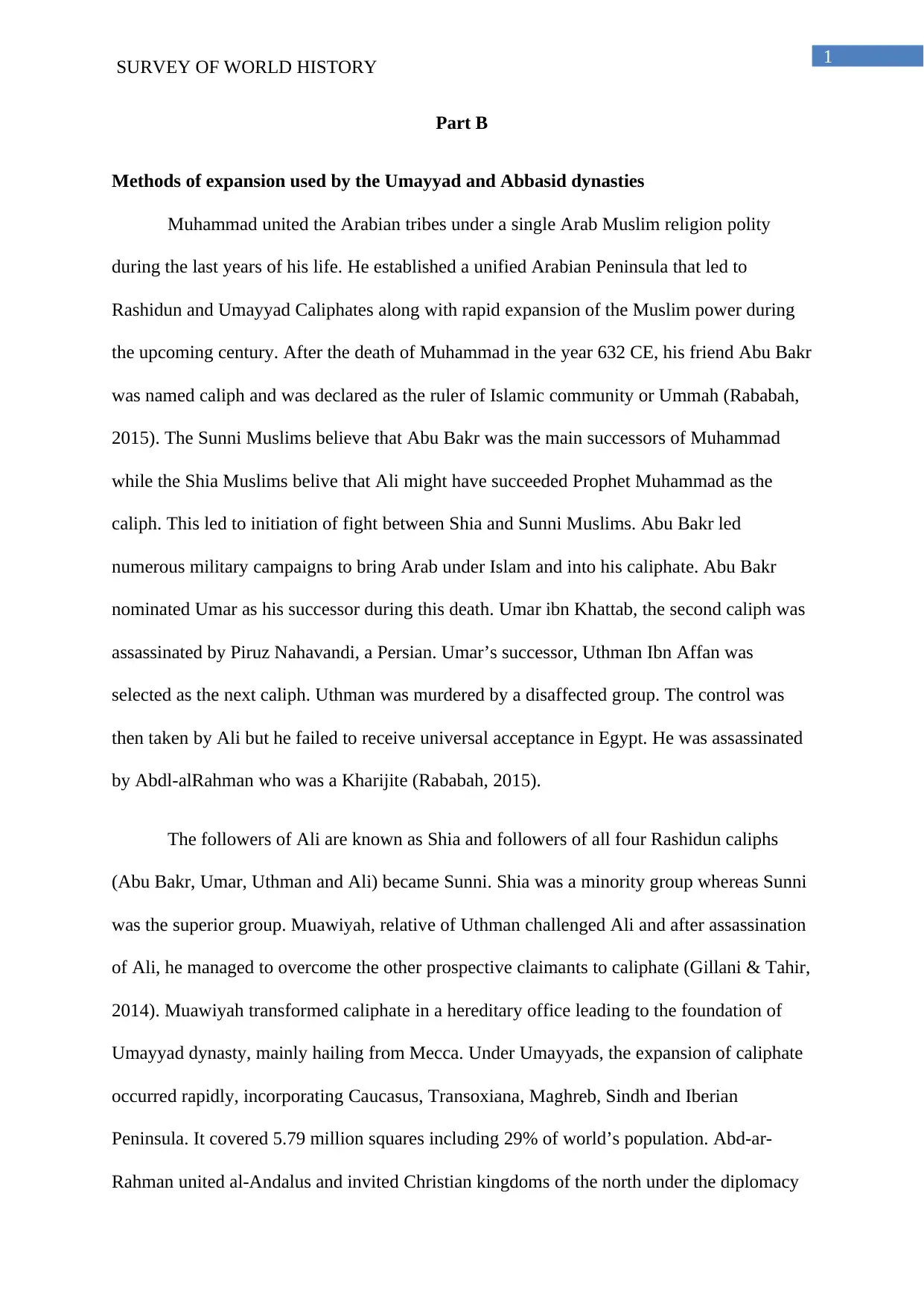
1
SURVEY OF WORLD HISTORY
Part B
Methods of expansion used by the Umayyad and Abbasid dynasties
Muhammad united the Arabian tribes under a single Arab Muslim religion polity
during the last years of his life. He established a unified Arabian Peninsula that led to
Rashidun and Umayyad Caliphates along with rapid expansion of the Muslim power during
the upcoming century. After the death of Muhammad in the year 632 CE, his friend Abu Bakr
was named caliph and was declared as the ruler of Islamic community or Ummah (Rababah,
2015). The Sunni Muslims believe that Abu Bakr was the main successors of Muhammad
while the Shia Muslims belive that Ali might have succeeded Prophet Muhammad as the
caliph. This led to initiation of fight between Shia and Sunni Muslims. Abu Bakr led
numerous military campaigns to bring Arab under Islam and into his caliphate. Abu Bakr
nominated Umar as his successor during this death. Umar ibn Khattab, the second caliph was
assassinated by Piruz Nahavandi, a Persian. Umar’s successor, Uthman Ibn Affan was
selected as the next caliph. Uthman was murdered by a disaffected group. The control was
then taken by Ali but he failed to receive universal acceptance in Egypt. He was assassinated
by Abdl-alRahman who was a Kharijite (Rababah, 2015).
The followers of Ali are known as Shia and followers of all four Rashidun caliphs
(Abu Bakr, Umar, Uthman and Ali) became Sunni. Shia was a minority group whereas Sunni
was the superior group. Muawiyah, relative of Uthman challenged Ali and after assassination
of Ali, he managed to overcome the other prospective claimants to caliphate (Gillani & Tahir,
2014). Muawiyah transformed caliphate in a hereditary office leading to the foundation of
Umayyad dynasty, mainly hailing from Mecca. Under Umayyads, the expansion of caliphate
occurred rapidly, incorporating Caucasus, Transoxiana, Maghreb, Sindh and Iberian
Peninsula. It covered 5.79 million squares including 29% of world’s population. Abd-ar-
Rahman united al-Andalus and invited Christian kingdoms of the north under the diplomacy
SURVEY OF WORLD HISTORY
Part B
Methods of expansion used by the Umayyad and Abbasid dynasties
Muhammad united the Arabian tribes under a single Arab Muslim religion polity
during the last years of his life. He established a unified Arabian Peninsula that led to
Rashidun and Umayyad Caliphates along with rapid expansion of the Muslim power during
the upcoming century. After the death of Muhammad in the year 632 CE, his friend Abu Bakr
was named caliph and was declared as the ruler of Islamic community or Ummah (Rababah,
2015). The Sunni Muslims believe that Abu Bakr was the main successors of Muhammad
while the Shia Muslims belive that Ali might have succeeded Prophet Muhammad as the
caliph. This led to initiation of fight between Shia and Sunni Muslims. Abu Bakr led
numerous military campaigns to bring Arab under Islam and into his caliphate. Abu Bakr
nominated Umar as his successor during this death. Umar ibn Khattab, the second caliph was
assassinated by Piruz Nahavandi, a Persian. Umar’s successor, Uthman Ibn Affan was
selected as the next caliph. Uthman was murdered by a disaffected group. The control was
then taken by Ali but he failed to receive universal acceptance in Egypt. He was assassinated
by Abdl-alRahman who was a Kharijite (Rababah, 2015).
The followers of Ali are known as Shia and followers of all four Rashidun caliphs
(Abu Bakr, Umar, Uthman and Ali) became Sunni. Shia was a minority group whereas Sunni
was the superior group. Muawiyah, relative of Uthman challenged Ali and after assassination
of Ali, he managed to overcome the other prospective claimants to caliphate (Gillani & Tahir,
2014). Muawiyah transformed caliphate in a hereditary office leading to the foundation of
Umayyad dynasty, mainly hailing from Mecca. Under Umayyads, the expansion of caliphate
occurred rapidly, incorporating Caucasus, Transoxiana, Maghreb, Sindh and Iberian
Peninsula. It covered 5.79 million squares including 29% of world’s population. Abd-ar-
Rahman united al-Andalus and invited Christian kingdoms of the north under the diplomacy
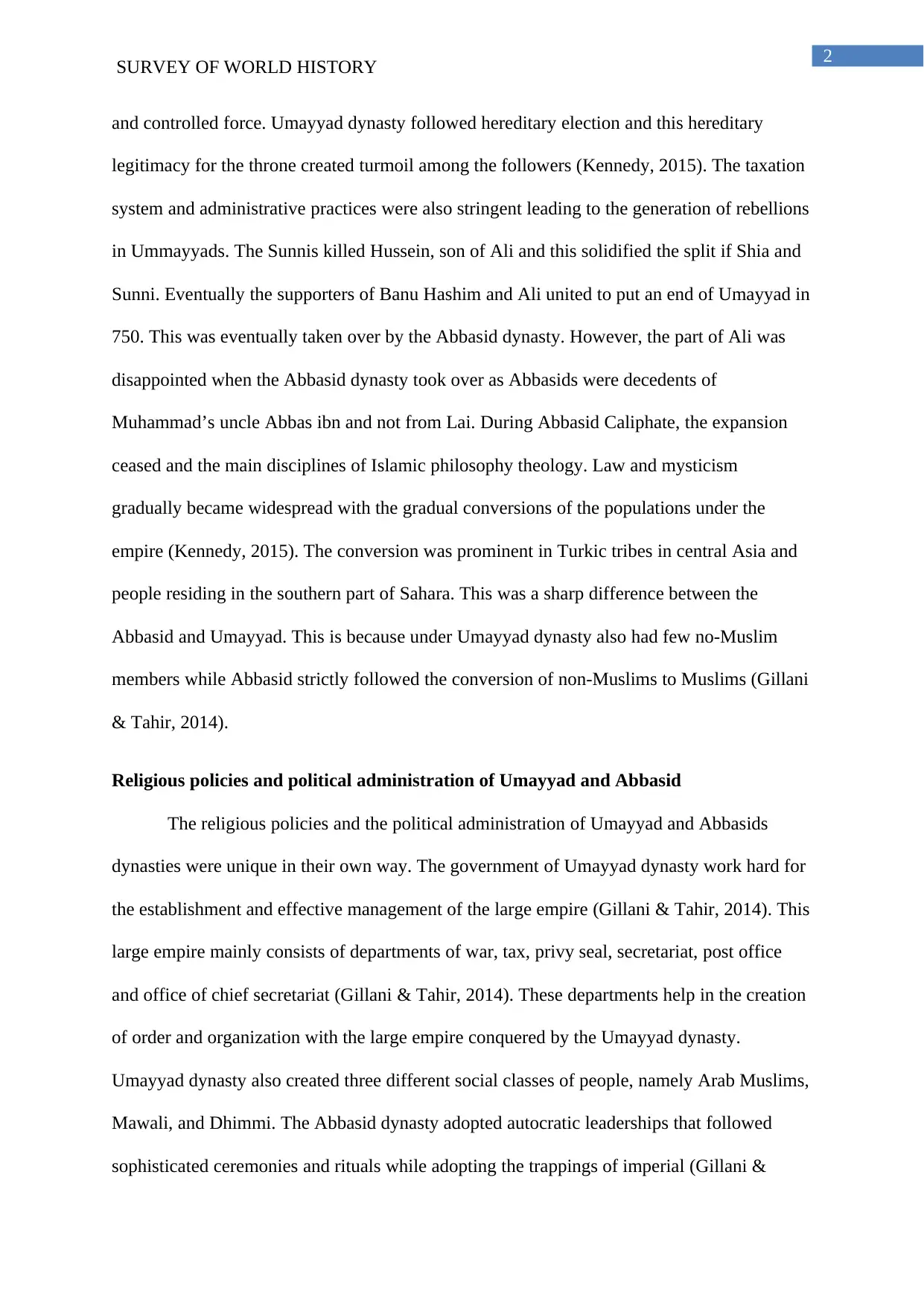
2
SURVEY OF WORLD HISTORY
and controlled force. Umayyad dynasty followed hereditary election and this hereditary
legitimacy for the throne created turmoil among the followers (Kennedy, 2015). The taxation
system and administrative practices were also stringent leading to the generation of rebellions
in Ummayyads. The Sunnis killed Hussein, son of Ali and this solidified the split if Shia and
Sunni. Eventually the supporters of Banu Hashim and Ali united to put an end of Umayyad in
750. This was eventually taken over by the Abbasid dynasty. However, the part of Ali was
disappointed when the Abbasid dynasty took over as Abbasids were decedents of
Muhammad’s uncle Abbas ibn and not from Lai. During Abbasid Caliphate, the expansion
ceased and the main disciplines of Islamic philosophy theology. Law and mysticism
gradually became widespread with the gradual conversions of the populations under the
empire (Kennedy, 2015). The conversion was prominent in Turkic tribes in central Asia and
people residing in the southern part of Sahara. This was a sharp difference between the
Abbasid and Umayyad. This is because under Umayyad dynasty also had few no-Muslim
members while Abbasid strictly followed the conversion of non-Muslims to Muslims (Gillani
& Tahir, 2014).
Religious policies and political administration of Umayyad and Abbasid
The religious policies and the political administration of Umayyad and Abbasids
dynasties were unique in their own way. The government of Umayyad dynasty work hard for
the establishment and effective management of the large empire (Gillani & Tahir, 2014). This
large empire mainly consists of departments of war, tax, privy seal, secretariat, post office
and office of chief secretariat (Gillani & Tahir, 2014). These departments help in the creation
of order and organization with the large empire conquered by the Umayyad dynasty.
Umayyad dynasty also created three different social classes of people, namely Arab Muslims,
Mawali, and Dhimmi. The Abbasid dynasty adopted autocratic leaderships that followed
sophisticated ceremonies and rituals while adopting the trappings of imperial (Gillani &
SURVEY OF WORLD HISTORY
and controlled force. Umayyad dynasty followed hereditary election and this hereditary
legitimacy for the throne created turmoil among the followers (Kennedy, 2015). The taxation
system and administrative practices were also stringent leading to the generation of rebellions
in Ummayyads. The Sunnis killed Hussein, son of Ali and this solidified the split if Shia and
Sunni. Eventually the supporters of Banu Hashim and Ali united to put an end of Umayyad in
750. This was eventually taken over by the Abbasid dynasty. However, the part of Ali was
disappointed when the Abbasid dynasty took over as Abbasids were decedents of
Muhammad’s uncle Abbas ibn and not from Lai. During Abbasid Caliphate, the expansion
ceased and the main disciplines of Islamic philosophy theology. Law and mysticism
gradually became widespread with the gradual conversions of the populations under the
empire (Kennedy, 2015). The conversion was prominent in Turkic tribes in central Asia and
people residing in the southern part of Sahara. This was a sharp difference between the
Abbasid and Umayyad. This is because under Umayyad dynasty also had few no-Muslim
members while Abbasid strictly followed the conversion of non-Muslims to Muslims (Gillani
& Tahir, 2014).
Religious policies and political administration of Umayyad and Abbasid
The religious policies and the political administration of Umayyad and Abbasids
dynasties were unique in their own way. The government of Umayyad dynasty work hard for
the establishment and effective management of the large empire (Gillani & Tahir, 2014). This
large empire mainly consists of departments of war, tax, privy seal, secretariat, post office
and office of chief secretariat (Gillani & Tahir, 2014). These departments help in the creation
of order and organization with the large empire conquered by the Umayyad dynasty.
Umayyad dynasty also created three different social classes of people, namely Arab Muslims,
Mawali, and Dhimmi. The Abbasid dynasty adopted autocratic leaderships that followed
sophisticated ceremonies and rituals while adopting the trappings of imperial (Gillani &
⊘ This is a preview!⊘
Do you want full access?
Subscribe today to unlock all pages.

Trusted by 1+ million students worldwide
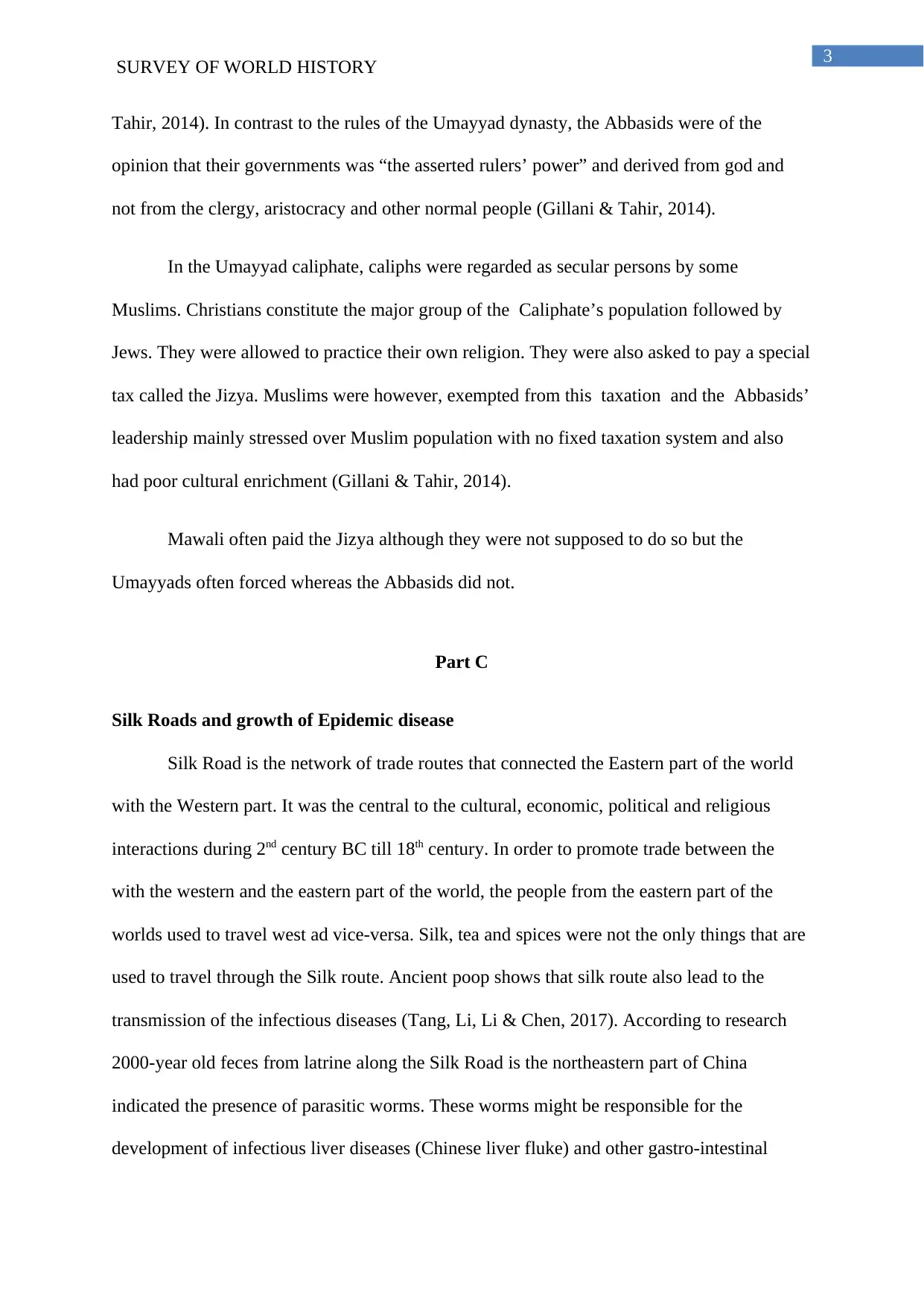
3
SURVEY OF WORLD HISTORY
Tahir, 2014). In contrast to the rules of the Umayyad dynasty, the Abbasids were of the
opinion that their governments was “the asserted rulers’ power” and derived from god and
not from the clergy, aristocracy and other normal people (Gillani & Tahir, 2014).
In the Umayyad caliphate, caliphs were regarded as secular persons by some
Muslims. Christians constitute the major group of the Caliphate’s population followed by
Jews. They were allowed to practice their own religion. They were also asked to pay a special
tax called the Jizya. Muslims were however, exempted from this taxation and the Abbasids’
leadership mainly stressed over Muslim population with no fixed taxation system and also
had poor cultural enrichment (Gillani & Tahir, 2014).
Mawali often paid the Jizya although they were not supposed to do so but the
Umayyads often forced whereas the Abbasids did not.
Part C
Silk Roads and growth of Epidemic disease
Silk Road is the network of trade routes that connected the Eastern part of the world
with the Western part. It was the central to the cultural, economic, political and religious
interactions during 2nd century BC till 18th century. In order to promote trade between the
with the western and the eastern part of the world, the people from the eastern part of the
worlds used to travel west ad vice-versa. Silk, tea and spices were not the only things that are
used to travel through the Silk route. Ancient poop shows that silk route also lead to the
transmission of the infectious diseases (Tang, Li, Li & Chen, 2017). According to research
2000-year old feces from latrine along the Silk Road is the northeastern part of China
indicated the presence of parasitic worms. These worms might be responsible for the
development of infectious liver diseases (Chinese liver fluke) and other gastro-intestinal
SURVEY OF WORLD HISTORY
Tahir, 2014). In contrast to the rules of the Umayyad dynasty, the Abbasids were of the
opinion that their governments was “the asserted rulers’ power” and derived from god and
not from the clergy, aristocracy and other normal people (Gillani & Tahir, 2014).
In the Umayyad caliphate, caliphs were regarded as secular persons by some
Muslims. Christians constitute the major group of the Caliphate’s population followed by
Jews. They were allowed to practice their own religion. They were also asked to pay a special
tax called the Jizya. Muslims were however, exempted from this taxation and the Abbasids’
leadership mainly stressed over Muslim population with no fixed taxation system and also
had poor cultural enrichment (Gillani & Tahir, 2014).
Mawali often paid the Jizya although they were not supposed to do so but the
Umayyads often forced whereas the Abbasids did not.
Part C
Silk Roads and growth of Epidemic disease
Silk Road is the network of trade routes that connected the Eastern part of the world
with the Western part. It was the central to the cultural, economic, political and religious
interactions during 2nd century BC till 18th century. In order to promote trade between the
with the western and the eastern part of the world, the people from the eastern part of the
worlds used to travel west ad vice-versa. Silk, tea and spices were not the only things that are
used to travel through the Silk route. Ancient poop shows that silk route also lead to the
transmission of the infectious diseases (Tang, Li, Li & Chen, 2017). According to research
2000-year old feces from latrine along the Silk Road is the northeastern part of China
indicated the presence of parasitic worms. These worms might be responsible for the
development of infectious liver diseases (Chinese liver fluke) and other gastro-intestinal
Paraphrase This Document
Need a fresh take? Get an instant paraphrase of this document with our AI Paraphraser
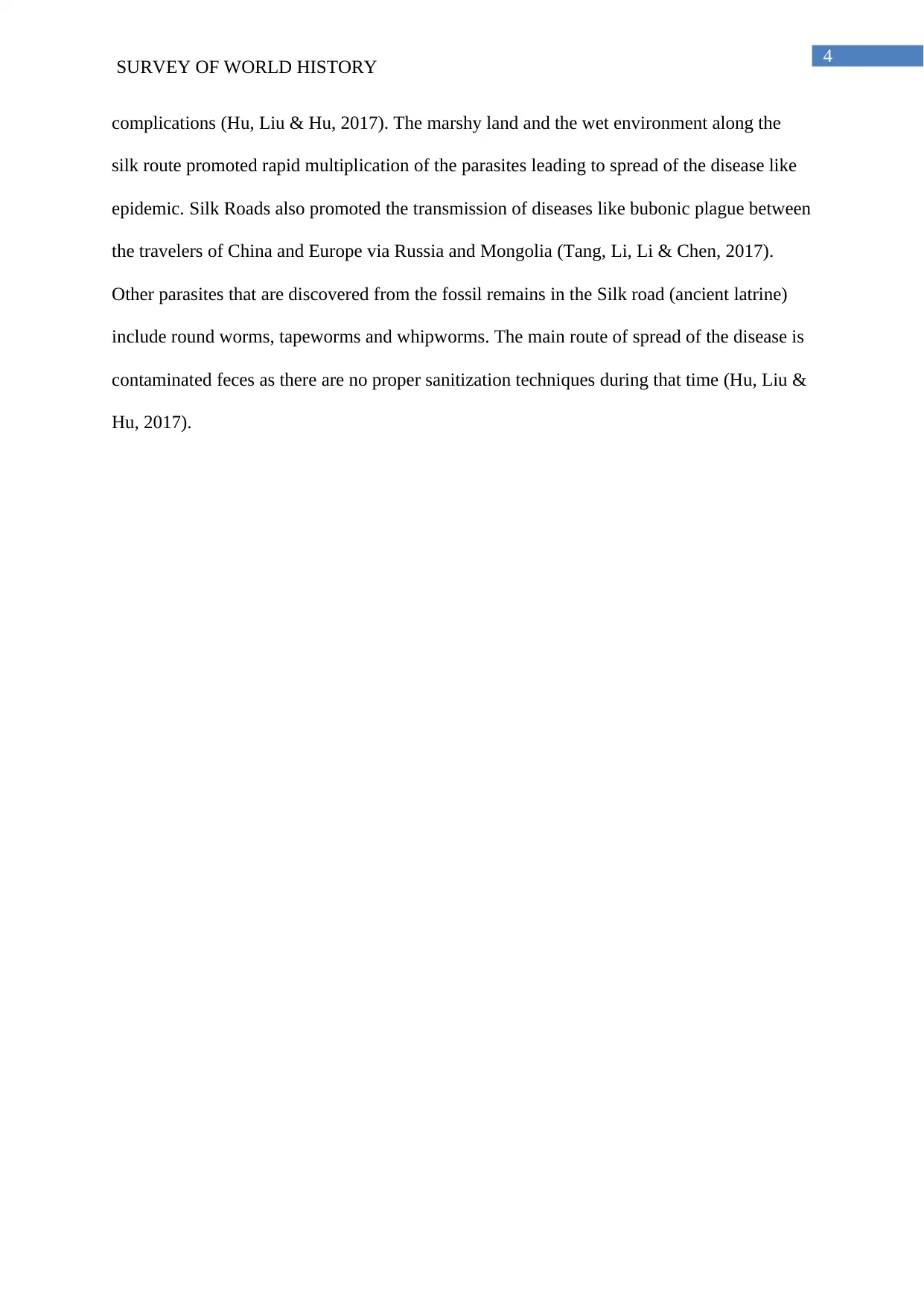
4
SURVEY OF WORLD HISTORY
complications (Hu, Liu & Hu, 2017). The marshy land and the wet environment along the
silk route promoted rapid multiplication of the parasites leading to spread of the disease like
epidemic. Silk Roads also promoted the transmission of diseases like bubonic plague between
the travelers of China and Europe via Russia and Mongolia (Tang, Li, Li & Chen, 2017).
Other parasites that are discovered from the fossil remains in the Silk road (ancient latrine)
include round worms, tapeworms and whipworms. The main route of spread of the disease is
contaminated feces as there are no proper sanitization techniques during that time (Hu, Liu &
Hu, 2017).
SURVEY OF WORLD HISTORY
complications (Hu, Liu & Hu, 2017). The marshy land and the wet environment along the
silk route promoted rapid multiplication of the parasites leading to spread of the disease like
epidemic. Silk Roads also promoted the transmission of diseases like bubonic plague between
the travelers of China and Europe via Russia and Mongolia (Tang, Li, Li & Chen, 2017).
Other parasites that are discovered from the fossil remains in the Silk road (ancient latrine)
include round worms, tapeworms and whipworms. The main route of spread of the disease is
contaminated feces as there are no proper sanitization techniques during that time (Hu, Liu &
Hu, 2017).
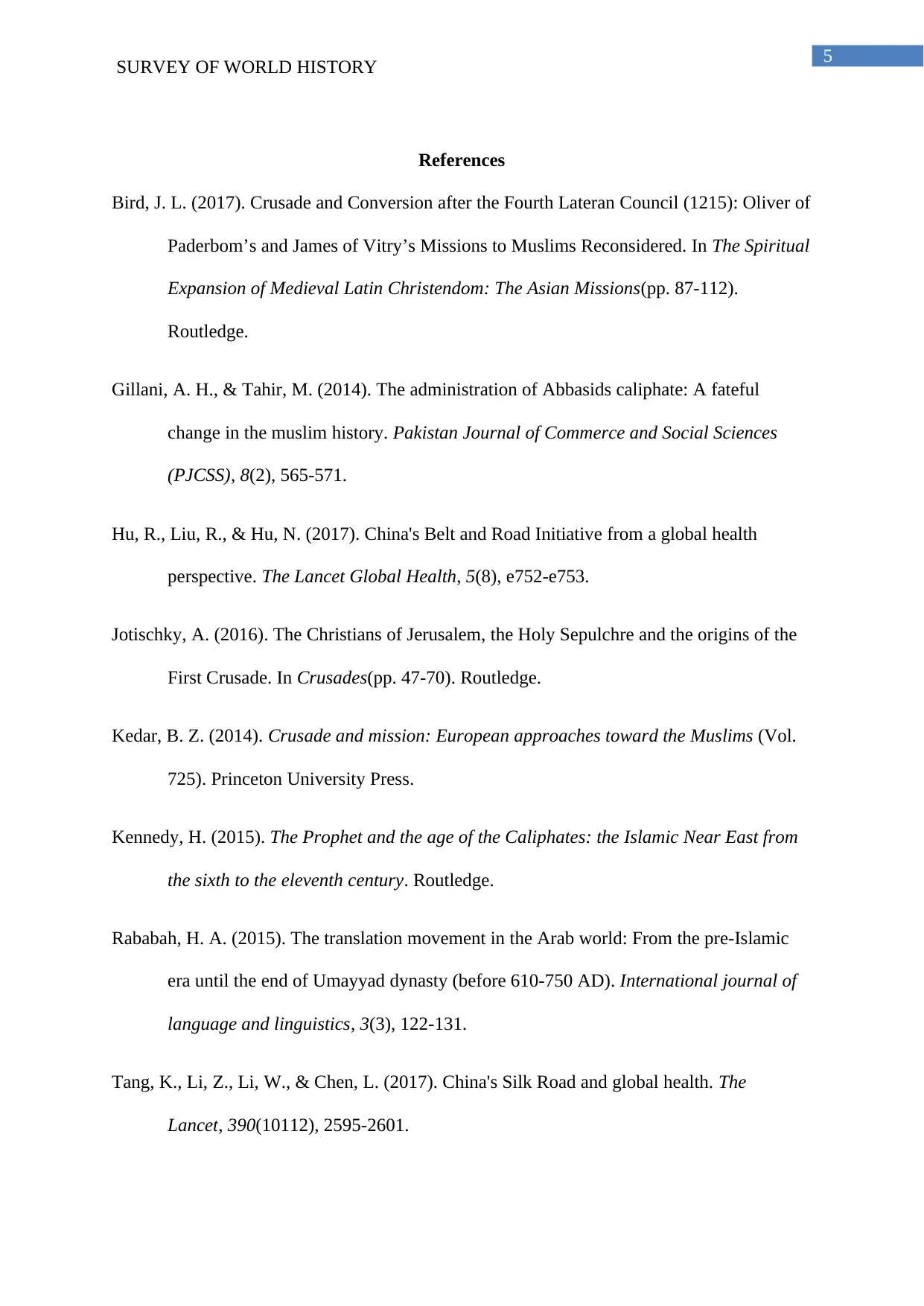
5
SURVEY OF WORLD HISTORY
References
Bird, J. L. (2017). Crusade and Conversion after the Fourth Lateran Council (1215): Oliver of
Paderbom’s and James of Vitry’s Missions to Muslims Reconsidered. In The Spiritual
Expansion of Medieval Latin Christendom: The Asian Missions(pp. 87-112).
Routledge.
Gillani, A. H., & Tahir, M. (2014). The administration of Abbasids caliphate: A fateful
change in the muslim history. Pakistan Journal of Commerce and Social Sciences
(PJCSS), 8(2), 565-571.
Hu, R., Liu, R., & Hu, N. (2017). China's Belt and Road Initiative from a global health
perspective. The Lancet Global Health, 5(8), e752-e753.
Jotischky, A. (2016). The Christians of Jerusalem, the Holy Sepulchre and the origins of the
First Crusade. In Crusades(pp. 47-70). Routledge.
Kedar, B. Z. (2014). Crusade and mission: European approaches toward the Muslims (Vol.
725). Princeton University Press.
Kennedy, H. (2015). The Prophet and the age of the Caliphates: the Islamic Near East from
the sixth to the eleventh century. Routledge.
Rababah, H. A. (2015). The translation movement in the Arab world: From the pre-Islamic
era until the end of Umayyad dynasty (before 610-750 AD). International journal of
language and linguistics, 3(3), 122-131.
Tang, K., Li, Z., Li, W., & Chen, L. (2017). China's Silk Road and global health. The
Lancet, 390(10112), 2595-2601.
SURVEY OF WORLD HISTORY
References
Bird, J. L. (2017). Crusade and Conversion after the Fourth Lateran Council (1215): Oliver of
Paderbom’s and James of Vitry’s Missions to Muslims Reconsidered. In The Spiritual
Expansion of Medieval Latin Christendom: The Asian Missions(pp. 87-112).
Routledge.
Gillani, A. H., & Tahir, M. (2014). The administration of Abbasids caliphate: A fateful
change in the muslim history. Pakistan Journal of Commerce and Social Sciences
(PJCSS), 8(2), 565-571.
Hu, R., Liu, R., & Hu, N. (2017). China's Belt and Road Initiative from a global health
perspective. The Lancet Global Health, 5(8), e752-e753.
Jotischky, A. (2016). The Christians of Jerusalem, the Holy Sepulchre and the origins of the
First Crusade. In Crusades(pp. 47-70). Routledge.
Kedar, B. Z. (2014). Crusade and mission: European approaches toward the Muslims (Vol.
725). Princeton University Press.
Kennedy, H. (2015). The Prophet and the age of the Caliphates: the Islamic Near East from
the sixth to the eleventh century. Routledge.
Rababah, H. A. (2015). The translation movement in the Arab world: From the pre-Islamic
era until the end of Umayyad dynasty (before 610-750 AD). International journal of
language and linguistics, 3(3), 122-131.
Tang, K., Li, Z., Li, W., & Chen, L. (2017). China's Silk Road and global health. The
Lancet, 390(10112), 2595-2601.
⊘ This is a preview!⊘
Do you want full access?
Subscribe today to unlock all pages.

Trusted by 1+ million students worldwide
1 out of 6
Your All-in-One AI-Powered Toolkit for Academic Success.
+13062052269
info@desklib.com
Available 24*7 on WhatsApp / Email
![[object Object]](/_next/static/media/star-bottom.7253800d.svg)
Unlock your academic potential
Copyright © 2020–2025 A2Z Services. All Rights Reserved. Developed and managed by ZUCOL.
